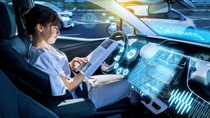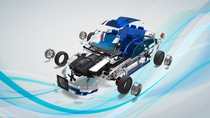On the road to Mobility 4.0

The race for the car of the future is on. Self-driving cars promise to disrupt the industry just as Henry Ford’s introduction of the first assembly line did more than a hundred years ago. People today expect tomorrow’s cars to come with fully digitized mobility, information and communication platforms. The first generation of digital natives1 wants their digital world to accompany them in the cockpit of their car, which makes software more important than ever before for automotive companies. Mobility is being redefined since digital innovations are not only bringing new products to market, they are also bringing new services. Connected vehicles deliver car manufacturers an excellent platform to develop new business models as providers of mobility services and to revolutionize how they interact with their customers.
The conjunction of cars and IT is transforming entire branches of industry. Germany has long been a global automotive industry leader, but competition never sleeps. Silicon Valley technology firms have their sights set squarely on car manufacturers: Google has been at the forefront with its driverless car division, while Uber, an online ride-booking service, is disrupting markets with a ride-sharing app. Not wanting to be left behind, the automotive industry is jumping on the bandwagon.
Take Toyota, which is partnering with Uber to position itself as a mobility services provider. Daimler snapped up the MyTaxi app, Volkswagen is investing in Gett, Uber’s Israeli-born rival. The Wolfsburg-based company makes no secret of the fact that the notion of robot taxis is what inspired the deal. The ride-sharing platform could “be a basis for developing workable models for on-demand operation of autonomous cars,” company sources say. They have figures, too: The new mobility solutions division is projected to generate billions in sales by 2025.

Autonomous driving is the great vision that has been inspiring the automotive and IT industry to work on the technology for some time now, including in joint ventures. The latest example is BMW’s team up with US chip manufacturer Intel, as well as the Israeli start-up and camera technology specialist Mobileye. The aim is to develop the technology for fully autonomous cars to go into mass production within the next five years. The technology in turn is to be the starting point for driverless ridesharing fleets of robot cars that pilot customers to their destination.
General Motors’ ambition is to be at the forefront of the robot taxi trend. The US car giant partnered up with Lyft, another rival of thee-hailing leader, Uber. The partners plan to build up a network of “permanently available autonomous vehicles,” the two companies announced. Uber in turn is collaborating with Volvo to develop proprietary technologies for robot cars. The Chinese web services company Baidu is also working to make the vision a reality. Expect autonomous cars to dominate our streetscape in five to ten years, the manufacturers say.
Meanwhile, the transportation manufacturing industry is poised to enter the digital era. Transport companies are taking things a step further by transforming themselves into suppliers of end-to-end solutions and mobility services. Trucks in the future will come equipped with their own drones, automated stacking systems that think ahead and place cargo in the right position all by themselves, as well as all sorts of software for digitally connected logistics systems. They will be smart data collectors as well. The technology promises to save time and boost efficiency.
On the logistics front, the first autonomous delivery robots are already taking shape. Postal services are introducing them step by step. Swiss Post has been testing autonomous delivery robots since September, 2016 and Hermes has announced plans to use mini-robots for parcel delivery in Germany. The industry wants to reach higher, too: with long-standing plans to use drones for deliveries. In fact, electronic retail company Amazon presented its second drone model for parcel transport last year. The Chinese e-commerce company Alibaba, Google, and logistics firms like DHL and UPS are working at full tilt to enable deliveries by drone.
Collective traffic management systems are major contributors to tomorrow’s mobility. These systems respond to the traffic situations by temporarily opening up emergency stopping lanes or adapting speed limits, while navigation systems help drivers to circumnavigate congestion and protect them with warnings of dangerous situations. WiFi is the technological basis for this communication. Environment sensors in the car, radar and cameras are the foundation of these assistance systems and show the way the future is likely to develop. A Connected Cars study by Pricewaterhouse Coopers gives an idea of the commercial potential of smart vehicles. The business consultants expect it to triple from an estimated €40.3 billion in 2016 to approximately €122.6 billion in five years’ time. Urban trends like car sharing will play a major role in driving inter-vehicle communication, the experts predict.
Driverless is one megatrend. Electric is the other. E-mobility will be a key ingredient of a smart, resource-saving urban lifestyle in future, experts say. The International Energy Agency predicts the number of electric vehicles on the road worldwide will increase from 2 million today to 20 million by 2020, and to 70 million by 2025. The Chinese government is set on bootstrapping its car industry into the electric age with tax breaks, research subsidies, among others. And the UK, France, Norway, India and several other countries intend to go one better by phasing out petrol and diesel engines entirely in the coming decades.
None of this will be possible without a parallel revolution in the way we store and transport energy. Affordable, high-performance batteries are necessary for the expansion of e-mobility and the integration of renewable energy. The cathode material is a key, as it determines the key properties of the battery such as its energy content, safety and life span. BASF is now researching and developing high energy cathode materials to improve existing battery system as well as to explore future batteries with high storage capacity.
well as to explore future batteries with high storage capacity. The lithium-ion battery is one of the major battery types for electric vehicles. For example, using lithium cobalt oxide for the cathode electrodes, it is high in energy density, but also very expensive. To make batteries more affordable, BASF replaces some of the cobalt with nickel, which is a fifth of the price. In some respects, nickel makes an even better cathode material because it has twice the energy density. But the oxygen in this mix can be released at a relatively low temperature, raising the risk of fire. The solution is to add another metal to stabilize the mix, usually manganese or aluminium, which are electrochemically less active.

Lithium-ion batteries generate current through the movement of ions and electrons. Another crucial role of cathode material is to enable the flow of ions. To provide high power, a battery must move large numbers of lithium ions quickly from the anode to the cathode. BASF’s researchers design cathode materials using small particles, which leave gaps for lithium ions to move in and out of quickly. It helps even more if the cathode material is porous: more holes means more space and greater ion flow. This kind of cutting-edge research should significantly lower the cost of batteries. Lithium-ion car batteries cost around $200 per kilowatt hour of energy.
Jeffrey Lou, who runs BASF’s global business unit for battery materials, thinks improved technologies will help bring the cost down steadily. “Innovation will be key on new product development, on efficient production processes and on the recycling of used batteries,” he says.
In the meantime, there has been exploration on a fossil-free transportation from an infrastructure side. In the north of Stockholm, Sweden, motorists can try out the world’s first public electric highway courtesy of the Swedish government, Siemens and Scania, a truck manufacturer. Overhead power lines are mounted over the truck lane on a two-kilometer stretch of road. Sensors on the roof of the Scania truck recognize them as power sources. A power collector over the cab extends out and connects with the power lines. The truck switches automatically to electric power. Siemens says energy consumption is half that of conventional power propulsion systems – a powerful argument in the exciting race for the mobility of the future.
* The article was published in “together” 1/2017, the magazine of Supply Chain Operations & Information Services (FS), BASF, and has been slightly modified.
A digital native is a person born or brought up during the age of digital technology and so familiar with computers and the Internet from an early age.


